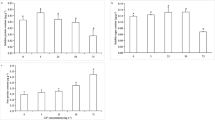Abstract.
Co-localization of polyphenols and peroxidase activity was demonstrated in epidermal glands of the waterlily (Nymphaea) by histochemistry. Total phenols, tannins and peroxidase activity were determined quantitatively in plant extracts. Polyphenols were partially identified and were found to consist mainly of hydrolyzable tannins, gallic and tannic acid derivatives.Nymphaea polyphenols were shown to chelate Cr, Hg, and Pb in vitro, and Cd-binding by polymerized polyphenols was demonstrated in leaves exposed to Cd in vivo. Both polyphenols and peroxidases were found at very high constitutive levels, which were not induced or altered by external conditions, such as light and heavy-metal stress. It is suggested that the polymerization of polyphenols by peroxidases, enhanced after heavy-metal uptake and detoxification, is responsible for the binding of heavy metals in Nymphaea epidermal glands.
Similar content being viewed by others
Author information
Authors and Affiliations
Additional information
Received: 29 April 2000 / Accepted: 8 June 2000
Rights and permissions
About this article
Cite this article
Lavid, N., Schwartz, A., Yarden, O. et al. The involvement of polyphenols and peroxidase activities in heavy-metal accumulation by epidermal glands of the waterlily (Nymphaeaceae). Planta 212, 323–331 (2001). https://doi.org/10.1007/s004250000400
Issue Date:
DOI: https://doi.org/10.1007/s004250000400




